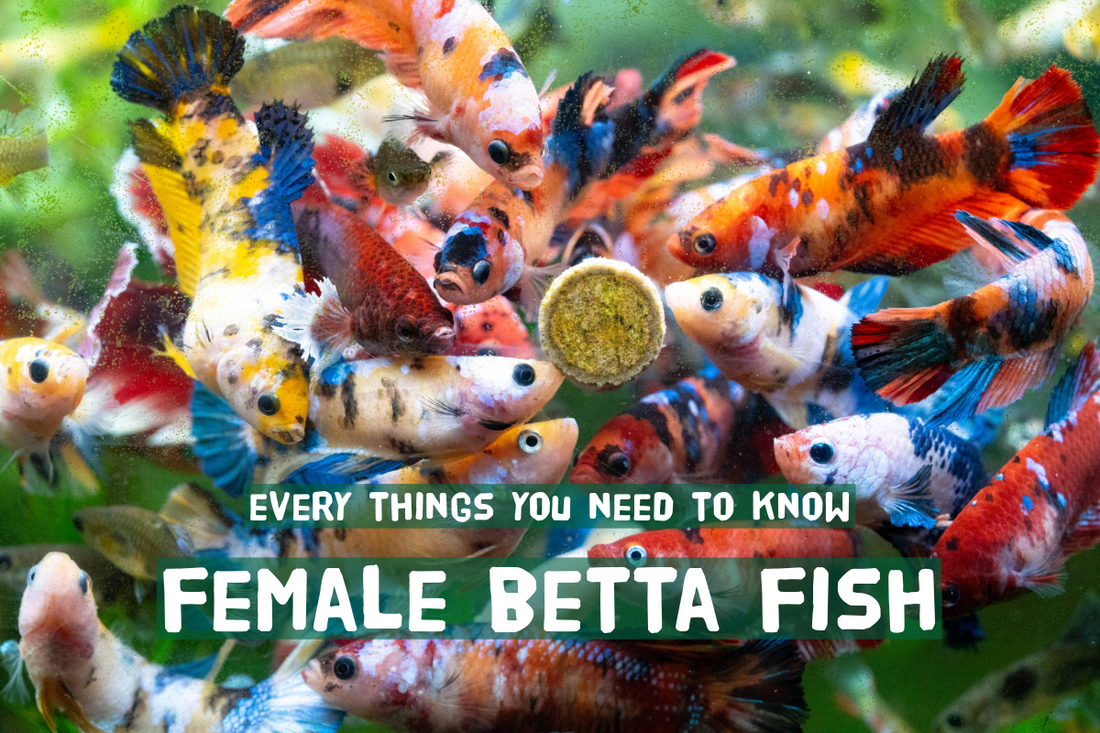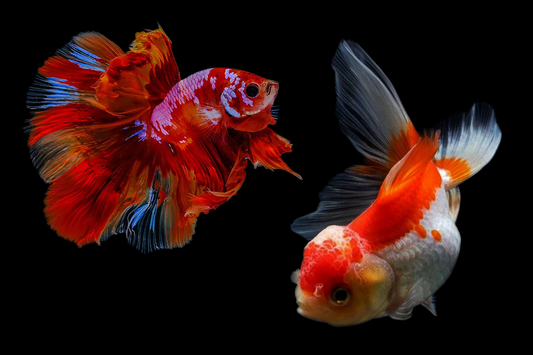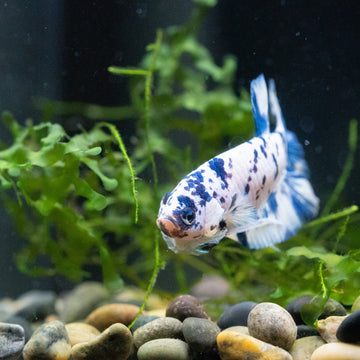Female Betta Fish - Everything You Need to Know

Contents
What is female betta fish
While male betta fish, often called fighter fish or Siamese Fighting Fish, tend to steal the spotlight, their female counterparts remain a hidden treasure in the world of aquarium enthusiasts due to a lack of awareness and unpopular. In this article, we will cover everything related to female betta fish, providing you with valuable insights and knowledge to help you care for these beautiful aquatic creatures and transform your female betta fish tank into a stunning haven for them.
Origin and Habitat
Betta fish, scientifically known as betta splendens, trace their origins to Thailand. In their natural habitat, these fish thrive in shallow freshwater environments, including swamps, marshes, and rice paddies.

Over the years, due to extensive breeding efforts, betta fish have gained immense popularity in Southeast Asian countries such as Malaysia, Singapore, Vietnam, and Cambodia.
These fascinating fish are known for their preference for warm waters, typically inhabiting temperatures ranging from approximately 59°F to 104°F. This warm aquatic environment teems with life, including various aquatic plants, snails, and other small creatures that serve as a source of food for betta fish.
Female Betta Fish Appearance
Unlike male bettas with their fancy halfmoon tails and varied colors, female Bettas showcase a wide range of colors and patterns. They possess long, flowing fins that can take on various shapes and colors. However, it's worth noting that female bettas typically have shorter fins and less extravagant finnage compared to their male counterparts.
What is difference between male and female betta

Male and female Betta fish, exhibit several differences in both physical and behavioral traits. Here are the key distinctions between the these factor
Physical Differences
Fins and Finnage
Male Betta fish display larger, more colorful fins with elaborate finnage, including a long pointed dorsal fin and a large, fan-shaped or halfmoon-shaped caudal fin. Females, on the other hand, have shorter, less ornate fins, with a smaller rounded dorsal fin, a shorter caudal fin, and a less extended anal fin compared to males.
Body Size
Male Bettas are generally slightly larger than females, both in terms of body length and overall size. They have a sleeker, more elongated body shape.
On the order hand female bettas tend to be smaller and possess a stockier body shape compared to males.
Coloration
Male Bettas are known for their vibrant and diverse colors, including shades of red, blue, green, and iridescent metallic tones. In contrast, females generally have more subdued colors, often in earthy tones like brown or olive, although some females can still display vivid hues.
Behavioral Differences
Aggression
Male bettas are notorious for their territorial and aggressive nature, often engaging in combat with other males they see as rivals, making solitary aquarium housing common. In contrast, female bettas are typically less aggressive, especially outside of breeding or nest-guarding periods, allowing them to coexist more harmoniously in well-maintained sorority setups with other female Bettas.
Interaction with Other Fish
Male bettas' aggressiveness often makes them unsuitable for community aquariums, as they may attack and harm other fish, especially those with vibrant fins or similar body shapes. On the other hand, female bettas can be more compatible in group (sororities) with specific community fish species, but cautious selection and vigilant monitoring of tankmates are essential to prevent aggression.
Nesting and Breeding
In the breeding process, male bettas are responsible for constructing bubble nests, showcasing intricate nest-building behaviors. On the other hand, female bettas contribute by laying eggs but do not engage in nest-building. Following egg laying, females may either be chased away by the male or become less involved in fry care.

How Many type of Female Betta Fish
Like male betta fish, there are several type of female betta which difference color and sharp of tail:
- Wild Female Betta: These are the closest in appearance to wild betta splendens.
- Veiltail Female Betta: Veiltail females have long, flowing fins, but their fins are not as extravagant or elaborate as those of male Veiltail Bettas.
- Crowntail Female Betta: Crowntail females have fins with a unique and distinctive appearance.
- Halfmoon Female Betta: Halfmoon females have fins that spread out in a semi-circular or "D" shape when fully extended.
- Plakat Female Betta: Plakat females betta, also known as short-tail females, have shorter fins compared to other Betta types.
Size of female betta fish
Regular size of female betta fish
On average, adult female betta fish typically reach a size of about 2 to 2.5 inches (5 to 6.5 centimeters) in length, excluding their finnage.
Giant Size of female betta fish

Giant female betta fish are typically larger than standard-sized female Betta fish, but their exact size can vary depending on factors such as genetics and breeding. On average, giant female Betta fish can reach a size of about 2.5 to 3 inches (6.5 to 7.5 centimeters) in length, excluding their finnage.
Care
Female betta fish is very easy to care for when compared to the other fish but they do need a property tank set up to live long and heathy life.
Tank Set Up
Female Betta Fish Sorority Tank
Tank size
Selecting an appropriate tank is the first crucial step. A tank with a capacity of 5 gallons or more is recommended for female betta fish, as it provides ample swimming space and helps maintain stable water conditions. However, 10 gallons tank is also more perfect for female betta fish.
Lighting
- LED Lights: LED (Light Emitting Diode) lights are a popular choice for betta tanks. They are energy-efficient, produce minimal heat, and come in various colors, allowing you to enhance the colors of your betta fish.
- Full Spectrum Lights: Full spectrum LED lights mimic natural sunlight and can promote the growth of live aquarium plants, if you have them in your tank.
- Submersible Lights: Some LED lights are submersible and can be placed directly underwater, creating unique underwater lighting effects.
Lighting for betta tank we are recommending:
For 5 gallon tank: SEAOURA Led Light SunGrow LED Aquarium
For 10 gallon tank: WATER BIRTH
Plant
Female Betta fish thrive in tanks with plenty of plants, which provide hiding spots and reduce stress. Some recommended plants include Java Fern, Anubias, Amazon Sword, Cryptocoryne, Dwarf Water Lettuce, Java Moss, Hornwort, Water Sprite, Duckweed, and Vallisneria.
Where to buy plant: BucePlant
Filter
Like another the tropical fish, female betta fish do need a good filter to keep water clean and less toxic. Here is a list of filter that you can use for your female betta tank:
Sponge Filter:
Pros:
Sponge filters provide a very gentle water flow, making them great ideal for betta tanks. They won't create strong currents that can stress your Betta. Sponge filters also offer excellent biological filtration as beneficial bacteria colonize the sponge's surface, helping to maintain water quality and it is very affordable price
Cons:
Most sponge filters require an air pump to operate. This adds an extra piece of equipment to your tank setup and it is primarily focused on biological filtration, so they may not be as effective at removing larger debris. However, regular water change is solution for it.
Hang-On-Back (HOB) Filter with Baffle:
Pros:
Many HOB filters come with adjustable flow rates, allowing you to reduce water flow to a betta-friendly level. HOB filters excel at mechanical filtration, effectively removing debris and keeping the water clear. And they are relatively easy to maintain and don't require an additional air pump.
Cons:
Without modifications, some HOB filters can have strong initial flow rates that may stress Betta fish. However, you can add a filter baffle or place a sponge in the outflow to reduce flow.
Filter brand we are recommending: Aqueon Filter / Aqua Clear Filter
Heater
Ensure your Betta fish thrives in the perfect tropical paradise with a Betta fish heater. Keep their water temperature stable and within the ideal range of 78°F to 80°F (25°C to 27°C) using a reliable and adjustable heater.
Water Parameter Kit
Measuring the water quality of your female betta fish tank is a very important part to keep your female betta live a long and healthy life. We recommend you measure the water once a week. Here are the key water parameters you should monitor and maintain for your Betta tank:
PH: 6.5 to 7.5
Temperature: 78°F to 80°F (25°C to 27°C)
Ammonia (NH3/NH4+): 0 ppm
Nitrite (NO2-): 0 ppm
Nitrate (NO3-): Below 20 ppm
Hardness (GH) and Alkalinity (KH): Ideal Range: GH: 4 to 8 dGH (degrees of General Hardness), KH: 3 to 8 dKH (degrees of Carbonate Hardness)
Chlorine and Chloramines: These harmful chemicals are commonly found in tap water. Always treat tap water with a water conditioner that neutralizes chlorine and chloramines before adding it to the aquarium.
Dissolved Oxygen: Adequate aeration and surface agitation should ensure a sufficient level of dissolved oxygen for Betta fish. Ensure the water surface is not stagnant to promote gas exchange.
Female Betta Fish Tank Maintenance
Maintaining a healthy and vibrant environment for your female Betta fish requires regular tank maintenance. Here's a step-by-step guide to help you keep their habitat clean and optimal:
- Regular Water Changes: Change approximately 25-30% of the tank water every 1-2 weeks. This helps remove accumulated waste and maintain water quality.- Quarantine New Additions: Quarantine new fish, plants, or decorations before introducing them to the main tank to prevent the spread of diseases and parasites.

Keeping Female Betta Fish Sorority
Keep them in a very large tank: A large tank provides female Betta fish with personal space. Additionally, growing aquarium plants provides spots for them to hide and helps prevent them from seeing each other.
Overstocking Your Female Betta Tank: This technique intentionally prevents female Betta fish from developing territories and singling out any bully fish. This technique is very helpful for Betta farms to save space. Based on our experience, you can keep 7-10 female betta fish in a 10 gallon tank, but keep an eye on your female Betta fish to remove any bullies, especially in the in the beginning. Any fish that is picking on the others may need to be removed from the tank.
Keeping Single Female Betta Fish
The easiest way to keep a single female Betta fish is to house her in a big tank equipped with plants and a filter.
Breeding Betta Fish
Breeding betta fish at home is possible and relatively easy. The key aspect of the process is safely introducing the male and female bettas, as male aggression can lead to harm or death of female betta fish. Here are the basic steps:
- Select a healthy breeding pair with vibrant colors and well-fed condition.
- Condition the pair in separate tanks with a nutritious diet for a few weeks.
- Prepare a breeding tank with the right size, filtration, and temperature control.
- Initially introduce the male and female with a divider or separate containers.
- Observe courtship behaviors, such as bubble nest building and color changes.
- Remove the divider when signs of courtship and mating readiness appear.
- Witness the spawning process as the male fertilizes the eggs in the bubble nest.
- Remove the female to prevent harassment by the male.
- Allow the male to care for the nest and fry during development.
- After hatching, provide appropriate feeding and ensure proper growth of the fry.
- As they grow, separate and care for the fry in individual containers.
- Be patient, attentive, and prepared for the responsibilities of raising the fry.
Food & Diet
Female Betta fish require a diet rich in protein, which should include prepared dried foods and live or frozen options. Their diet can mirror that of male Bettas. A top-quality floating micro-pellet or flake food serves as their primary daily food source, but it's essential to enhance their diet a few times a week with live or frozen offerings like brine shrimp and bloodworms. These supplements will enhance their color and overall health.
Female Betta Fish Food we are recommending: Hikari Betta Bio Gold Ultra Fresh Betta Fish Food Bloodworm
How Often to Feed Female Betta Fish?
You can feed your female betta fish once or twice daily. Designate one day each week to fast your fish, which can reduce the risk of bloating. Rest assured, your fish can go without food for several days without any problem.
Overfeeding poses a significant danger to your female betta and can lead to a decline in aquarium water quality. Only provide your female betta with as much food as it can consume within a minute, and promptly remove any uneaten portions from the tank.
The role of Bloodworms in Female Betta Fish Care
Bloodworms play a pivotal role in supporting the reproductive health of female betta fish. When preparing to breed, female bettas need a diet that boosts their energy and prepares them for the rigors of the breeding process. Bloodworms provide the necessary sustenance to keep them in prime condition during this critical phase.

Common Diseases in Female Betta Fish
Female Betta fish are spotlight for their elegance and grace, but like all pets, they can be susceptible to health issues. To ensure the well-being of your vibrant aquatic companions, it's essential to be aware of common diseases that can affect female Betta fish and take proactive steps to prevent and address them.
Ich (White Spot Disease)
Ich, or white spot disease, is one of the most prevalent ailments affecting betta fish, both male and female. It manifests as tiny white spots on their scales, fins, and gills. Ich is often brought about by stress, poor water quality, or sudden temperature fluctuations. To prevent this disease, maintain stable water conditions, quarantine new additions, and provide a balanced diet to bolster your betta's immune system.
Fin Rot
Fin rot is a bacterial infection that can deteriorate a betta's beautiful fins (halfmoon and plakat), causing them to appear ragged and frayed. It is crucial to maintain pristine water quality and avoid overcrowding to prevent fin rot. If you notice any signs, promptly isolate the affected fish and treat them with antibiotics under the guidance of an aquatic veterinarian.

Velvet Disease
Velvet disease, or gold dust disease, is a parasitic infection characterized by tiny golden or rust-colored specks on the skin and gills. Maintaining stable water parameters, avoiding overcrowding, and maintaining a stress-free environment can help prevent velvet disease. Quarantine new fish arrivals to prevent the spread of this highly contagious disease.
Dropsy

Dropsy is a severe condition that causes fluid accumulation within the body, resulting in a swollen appearance. It can be caused by various factors, including poor water quality, overfeeding, or bacterial infections. Prevention involves maintaining excellent water conditions, providing a well-balanced diet, and promptly treating any infections.
Columnaris (Mouth Fungus)
Columnaris is a bacterial infection that typically appears as white, fuzzy growth around the mouth and fins of betta fish. To prevent this disease, maintain clean water and minimize stress. If your female betta shows symptoms, seek immediate treatment with appropriate antibiotics.
FAQ
Are Female Betta Fish Peaceful?
Female bettas are generally more peaceful than males, it is essential to provide them with the right environment which is space, plant to hide. Keep in mind that individual personalities can vary, so some female bettas may be more aggressive than others.
Trick for Choosing Female Betta Fish?
A key strategy for creating a less aggressive female betta community is the deliberate selection of female bettas that share a common history of being born and raised together from their earliest days. This means they have developed a natural bond with one another, having been nurtured and conditioned in the same environment since birth
Is It Normal When My Female Betta Start Chasing Each Other?
It is totally normal! Female bettas are known for their lively antics and playful behavior. They might chase each other as they establish their pecking order, but it is usually harmless. Just ensure you've got some hiding spots and plants in their crib for quick getaways. However, keep an eye on the situation and be prepared with a backup tank just in case things escalate and they become more aggressive
Are Female Betta Fish Friendly Tankmate?
Female betta fish are awesome tankmates with great personalities. They can become friend with fish such as guppies, tetras,...
How Can I Tell My Betta is Boy Or Girl?
Typically, female bettas exhibit less vibrant colors and possess smaller fins. In terms of body shape, they tend to be slightly shorter and wider than males. Additionally, females may feature an egg spot and vertical bars on their bodies, serving as distinct markers of their gender.
Where to Buy Female Betta Fish
When it comes to purchasing Female Betta fish, Tropicflow stands as a reputable and trustworthy source for both female and male specimens. Offering a 100% live arrival guarantee, Tropicflow provides you with the peace of mind you need when adding these exquisite female betta to your aquarium.
Conclusion
Female Betta fish often go underappreciated in the hobby from their vibrant colors to their distinct behaviors, female bettas are captivating aquatic companions . These tropical fish are ideal pets for individuals at all levels of expertise in the world of aquariums. Understanding their unique traits, ideal habitats, feeding requirements, and potential health concerns is crucial for providing them with the best care and heathy life.
No comments











0 comments